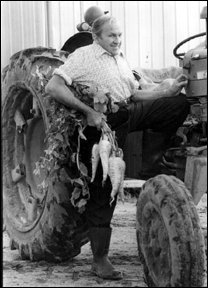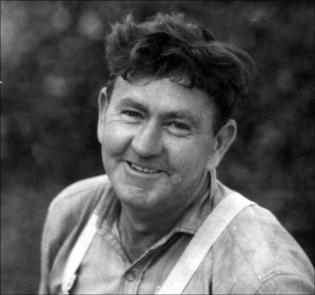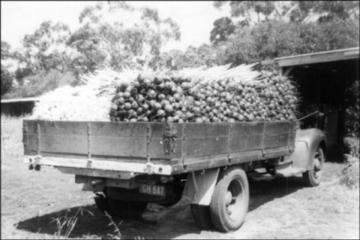Market Gardening In Kingston

Frank LePage on the Centre Dandenong Road, Cheltenham property 1984.
Two former market gardeners whose families lived in the Kingston district for many years recall the "back breaking" nature of their work, the crops they planted and the cultivation strategies they employed to maintain the fertility of the soil.
Francis (Frank) Le Page was born at home in Wilson Street, Cheltenham on January 31, 1919. He is the second son of Everest Le Page in a family of six children. Frank’s family has a long association with Cheltenham. His great grandfather, Nicholas Le Page, a tailor, from Guernsey in the Channel Islands purchased a two acre block on Chesterville Road near Bernard Street, Cheltenham to establish a market garden. Later Nicholas’s son, Frank T Le Page who worked for his father, and who previously had been employed as a coachman to a Melbourne bookmaker and worked at Brighton Grammar School, bought land adjoining his father’s and build a house known as Daphne Cottage in 1876. (Cribbin J., 1995:37) Everest Le Page was Frank T’s son and the father of Francis Wilbur LePage.
After leaving school Frank did various jobs in offices in the city for a while but he didn’t like being inside so he got his father to let him work in the garden. Frank commented, "At that time it was not easy to get a job because we were coming out of the Depression. I kept working as a market gardener after Dad died until I retired in 1980. When Dad died the land he had had to be sold so two of my brothers and I bought land opposite the Moorabbin Airport. I retired in 1980 and my brother Len took this land over but I kept giving him a hand until 1995."
Frank described the work of a market gardener as "continuous back bending hard work which required you to work in all kinds of weather. When I started we used a single furrow plough pulled by a horse. Generally we started work at seven o’clock and finished at five or six in the afternoon. On market morning we would be out bunching carrots and parsnips in threes, whereas now they are bought by weight, and loading the truck ready to leave the next morning at two o’clock. It was in 1927 that Dad bought his first truck and we went to the Victoria Market twice a week with a load of vegetables. We would back the load in and greengrocers would walk up and down between the rows of growers and select what they wanted and make a deal. We would finish up and drive home after throwing a load of stable manure on the truck from stables in City Road, South Melbourne. They were carriers who had council contracts. By the time we got home it was time for lunch. If you had something to do you would do it or you would go to sleep for an hour or two."

Charles Edward Burgess.
Charles Burgess’s family moved from Clarinda in 1938 to a rented property in "Old Dandenong Road, Heatherton. His son, Charles Edward said, "It didn’t have a number then. It was the second market garden around from the school on the left hand side. We were market gardeners, farming a few acres of land and growing about two or three crops a year on the one piece of ground."
"At Heatherton there was no mechanical equipment, we used a horse and a single furrow Oliver plough like the early settlers used. I was using one of those ploughs for years. We only had one horse at a time but when one got too old you got another one. We never had two horses. Later on we got a tractor. That was different altogether from working with a horse. While there we grew root vegetables like beetroot, carrots, parsnips and lettuce and cabbage. Market gardeners talked about their crops as ‘cut stuff’, ‘small stuff’ and ‘bunched stuff’. They were just names for what you were doing; bunching stuff like carrots and parsnips, growing spring onions and radishes or cutting cabbages and lettuces. Really it was a simple operation but there was work all the time."

Bunched stuff ready for market.
"Because you don’t have a lot of acreage you can’t leave the land fallow. What you do is rotate the ground with different crops. One crop would be a root crop and the next one you try and put a cut crop like cabbages. You might have two or three crops a year. But you would have to add fertiliser, artificial or cow manure or stable manure. With intensive farming you had to look after your ground. You couldn’t wait for nature to take its course and bring the ground back, you had to feed it. We would go to the local poultry farm and clean out the pens and pay so much a bag for it. In earlier days when there were more horses about there was a lot more stable manure. With the disappearance of horses, manure was not so available."
